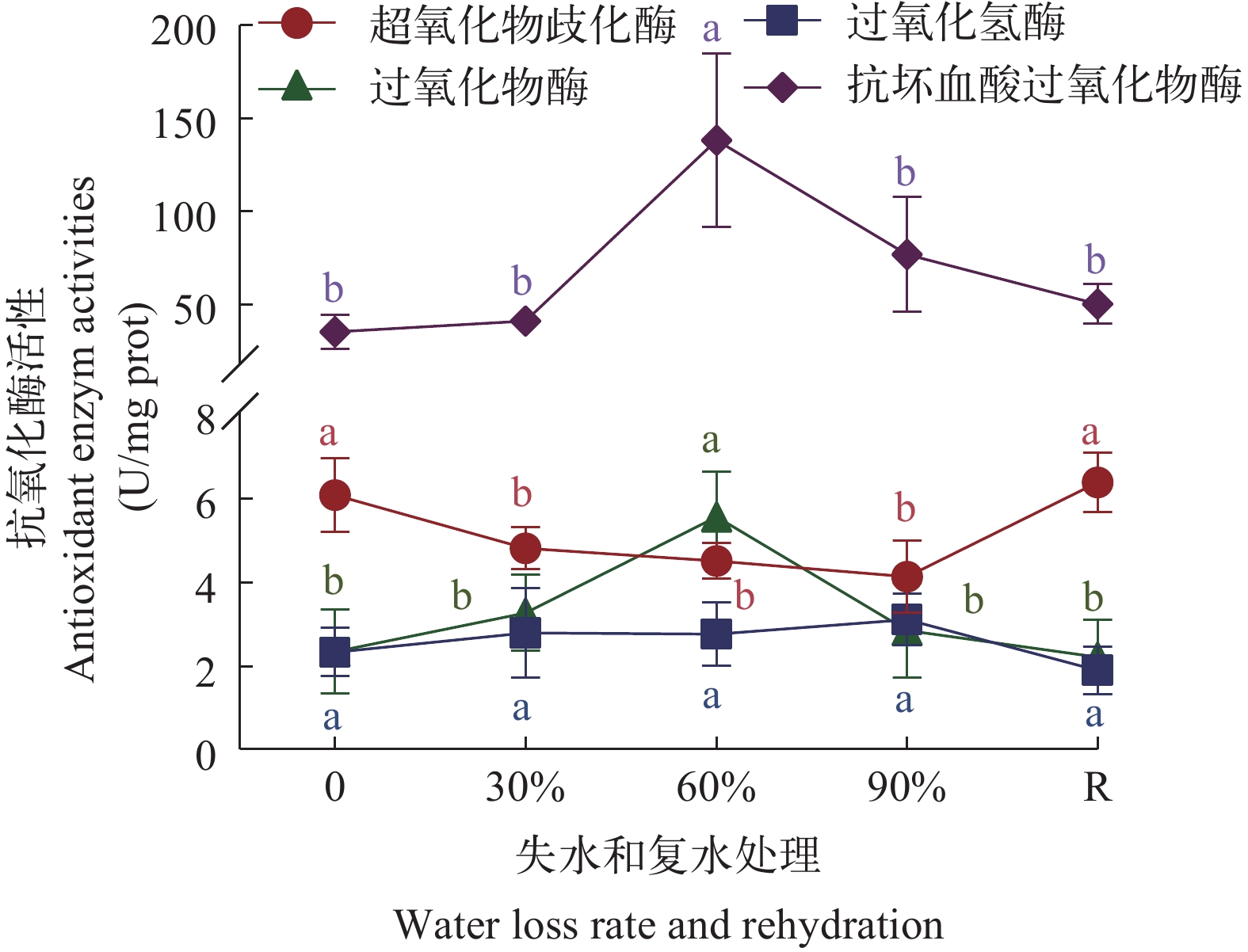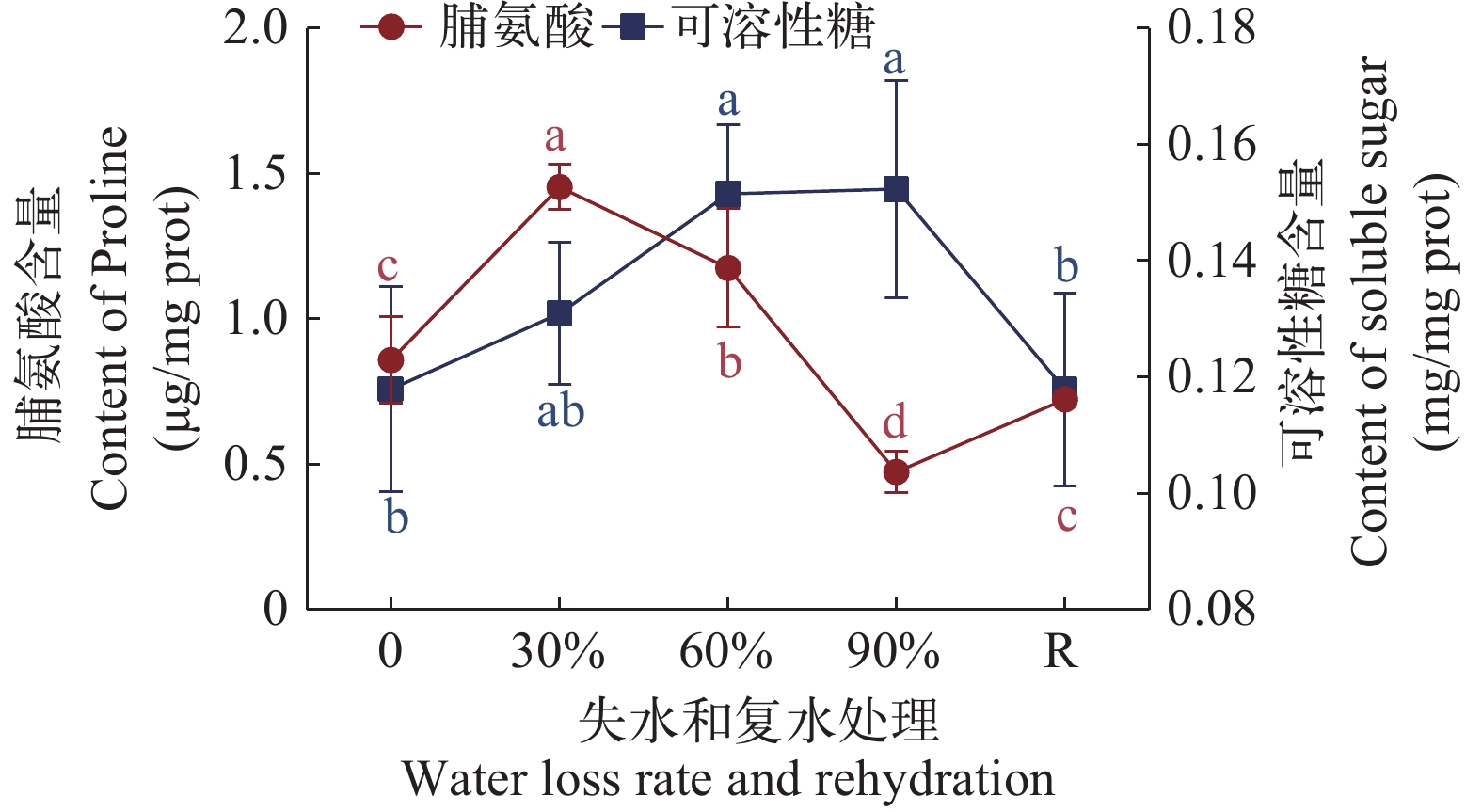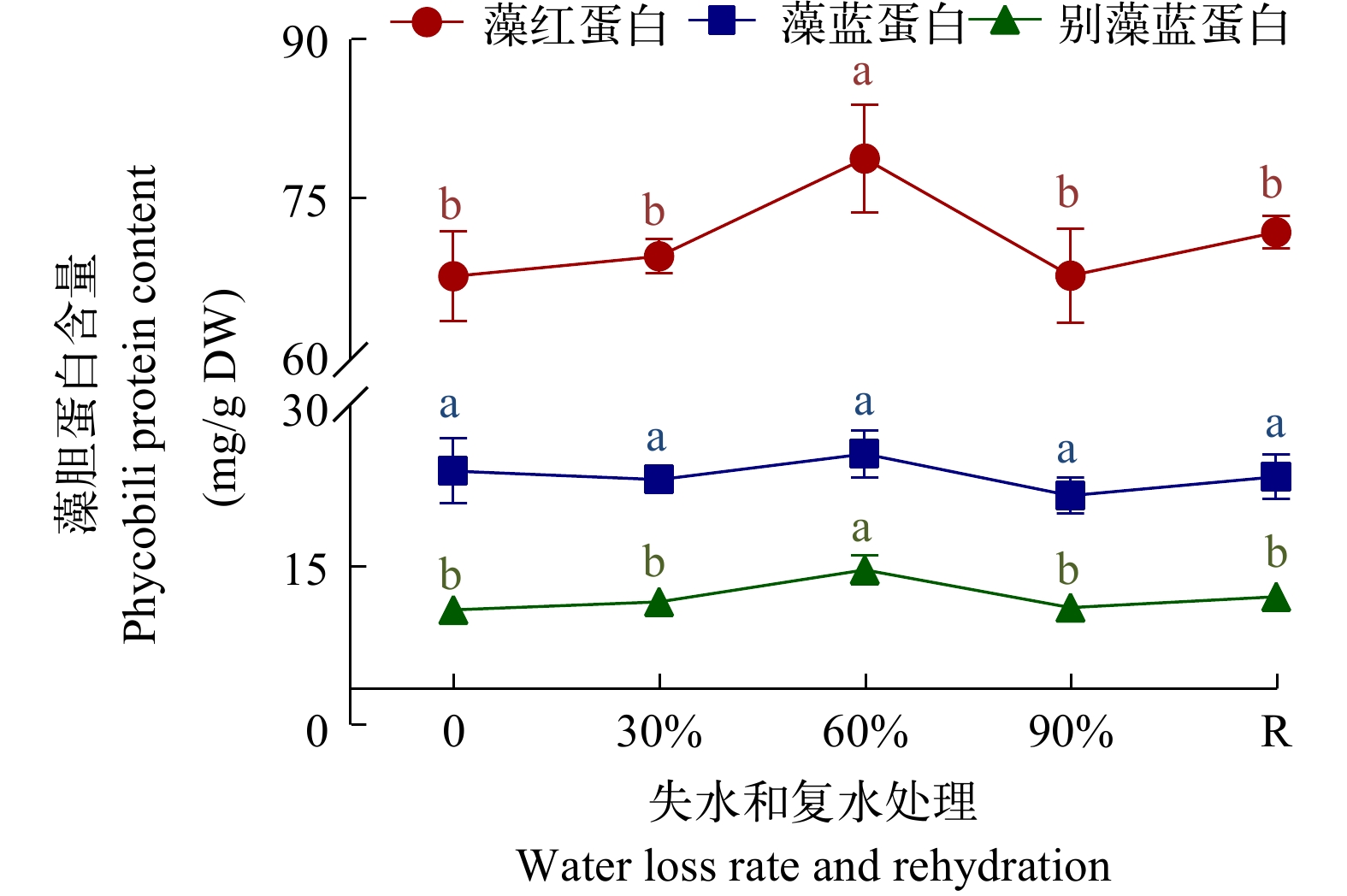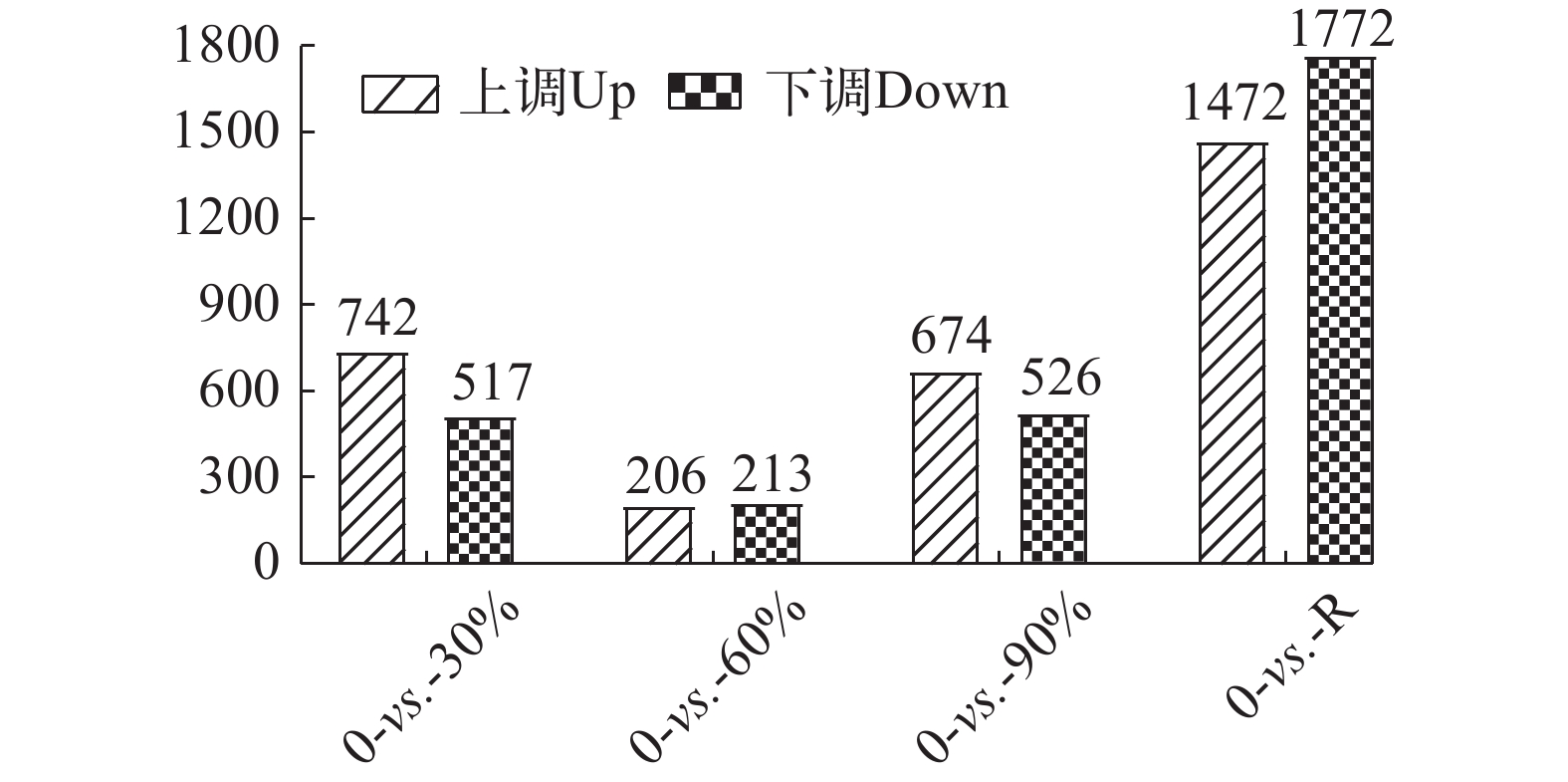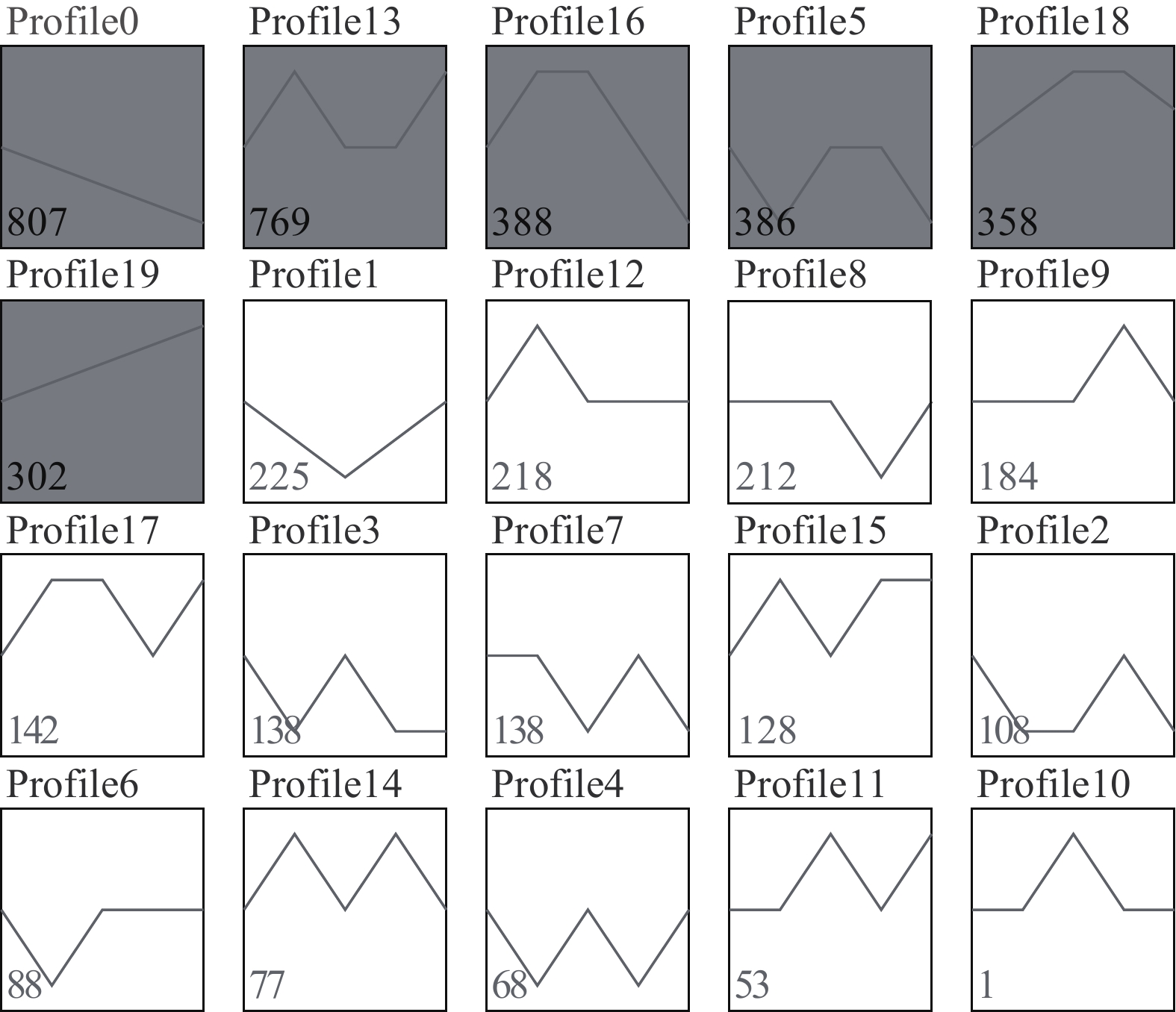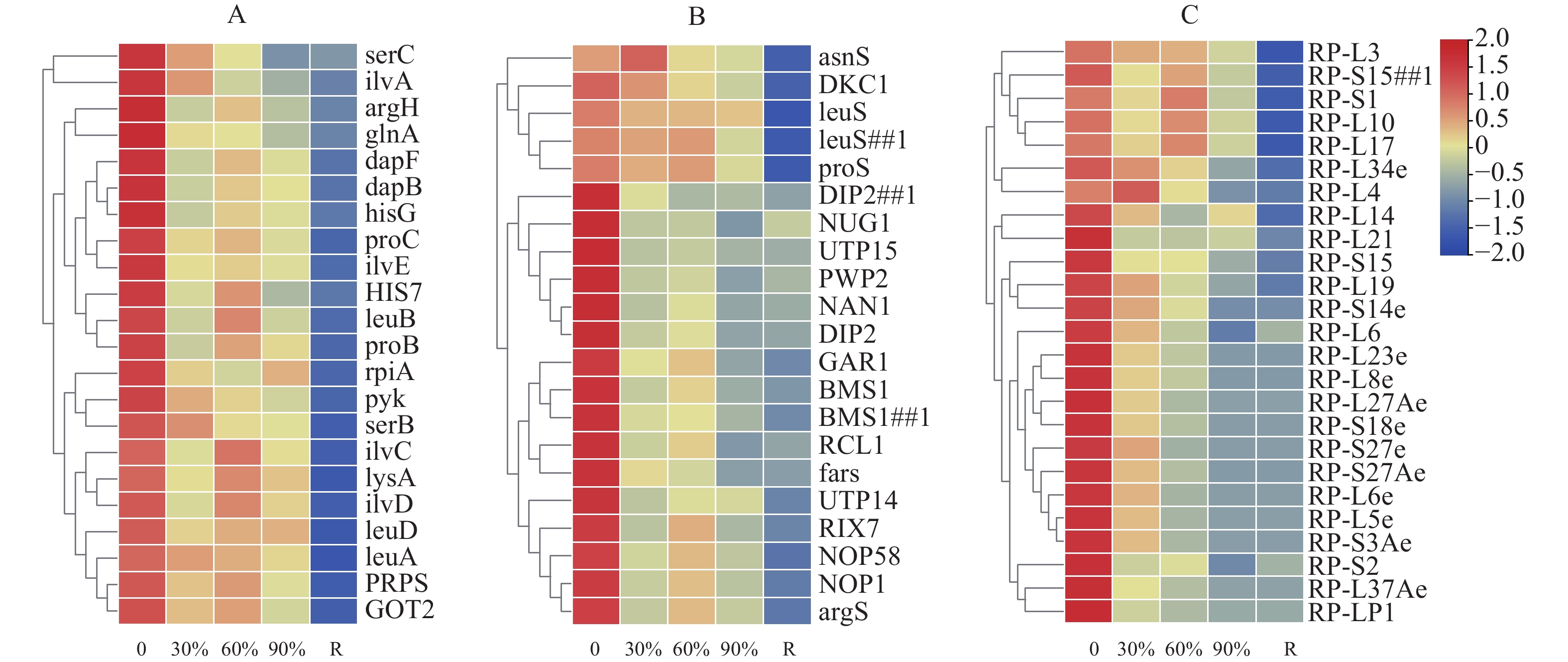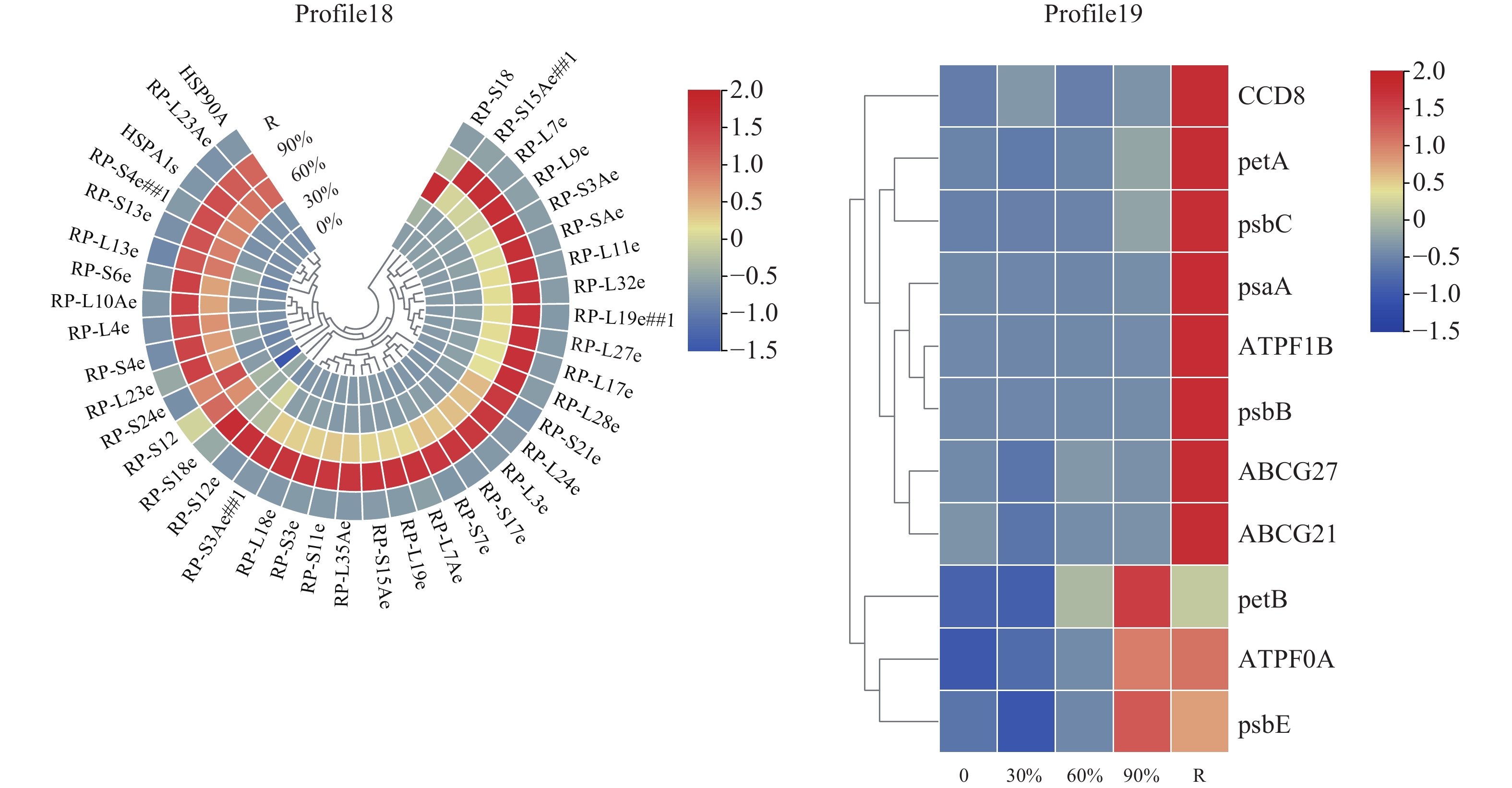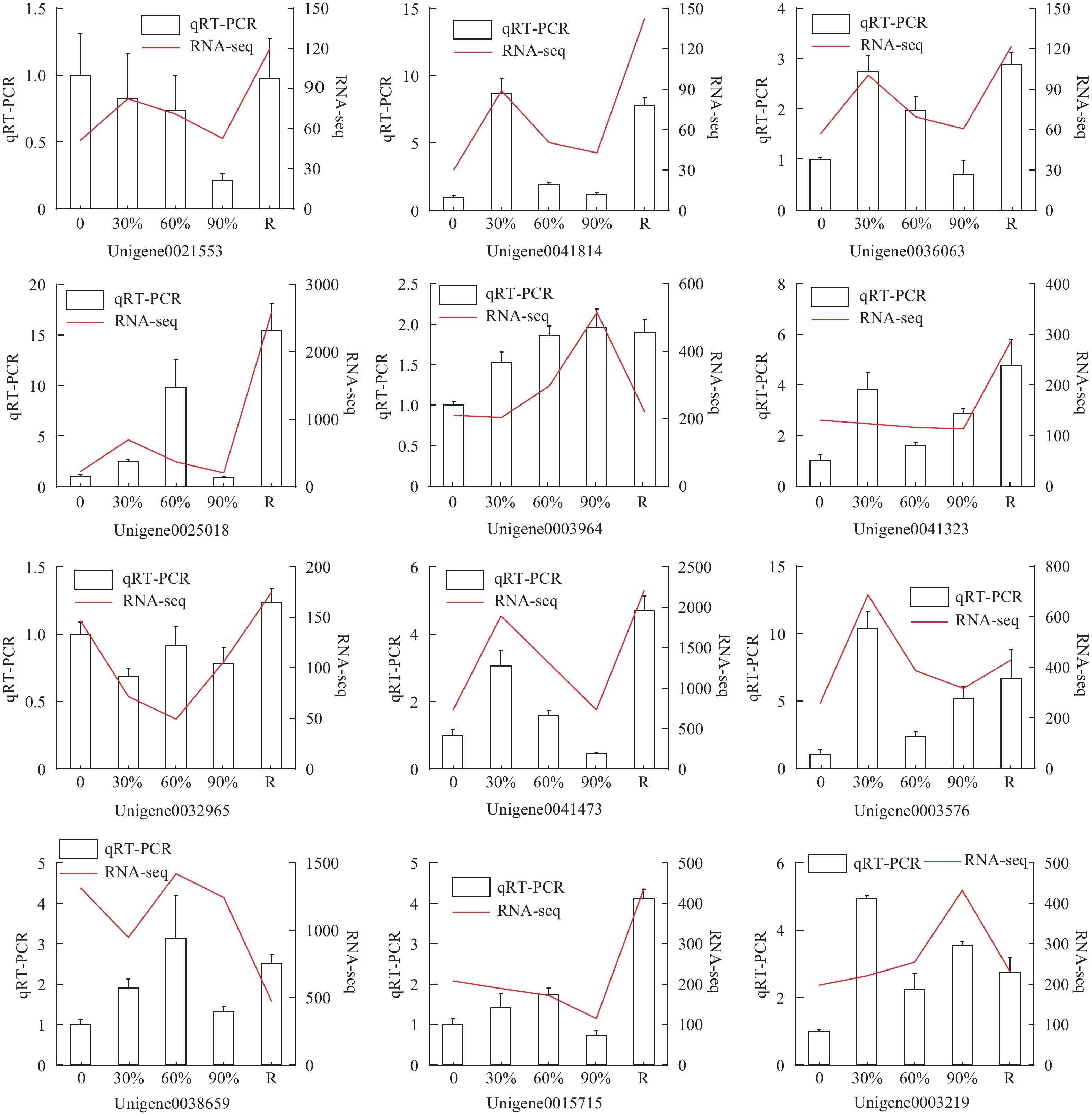PHYSIOLOGICAL PERFORMANCE AND TRANSCRIPTIONAL ANALYSIS OF BANGIA FUSCOPURPUREA IN RESPONSE TO DEHYDRATION AND REHYDRATION
-
摘要:
为探究红毛菜(Bangia fuscopurpurea)适应潮汐快速变化的机制, 研究选取野生红毛菜品系CY作为实验对象, 将红毛菜原叶体在5个失水梯度(WL0%、30%、60%和90%)及复水状态(先在90%失水状态下保持2h然后再复水)下保持2h, 从生理和转录表达水平分析其对失水/复水处理的应答机制。结果显示: 红毛菜超氧阴离子(${\mathrm{O}}^-_2 $)、过氧化氢(H2O2)、丙二醛(MDA)、脯氨酸、可溶性糖、藻红蛋白和别藻蓝蛋白含量在失水时上升; 超氧化物歧化酶(SOD)及最大光化学量子产率(Fv/Fm)在失水时下降; 抗坏血酸过氧化物酶(APX)和过氧化物酶(POD)的活性在失水60%时显著升高后下降; 而过氧化氢酶(CAT)无显著变化。在复水后, 所有生理指标均恢复至未失水处理下的水平。此外, 通过差异表达基因(DEGs)富集分析, 发现核糖体蛋白和热激蛋白相关基因在失水过程中上调表达, 而氨基酸合成等相关基因在复水后下调表达。综上所述: 红毛菜通过调节抗氧化酶活性及合成失水耐受相关核糖体蛋白等防御功能以应答失水胁迫; 在复水过程中, 通过抑制核糖体蛋白质合成及增强光合作用供给能量和转运有毒代谢产物以帮助红毛菜恢复生理代谢活动。研究可以加深对潮间带海藻应答失水胁迫的认识, 以及为红毛菜耐干良种选育提供数据参考。
Abstract:Thalli of the economically important red alga Bangia fuscopurpurea mainly inhabit the intertidal rocks. Consequently, they experience approximately two dehydration/rehydration cycles per day. During the tidal cycle, the thalli can lose around 90% of water at low tide and rapidly recover to normal water content after rehydration, indicating that B. fuscopurpurea has the ability to adapt to the rapid water changes induced by the tidal cycle. However, litter is known about the mechanisms by which B. fuscopurpurea adapts to tidal changes. Therefore, a wild strain of B. fuscopurpurea was used to assess its response to 2h dehydration (with 5 water loss rates: 0, 30%, 60%, 90%) and 2h rehydration (pretreated with 2h dehydration at a 90% water loss rate) by examining physiological traits and the transcriptome. The present study found that the maximum photochemical quantum yield (Fv/Fm) of B. fuscopurpurea decreased significantly with the increasing dehydration level. Meanwhile, the contents of superoxide anion (${\rm{O}}^-_2 $) and hydrogen peroxide (H2O2) increased significantly and peaked at 30% and 60% water loss, respectively. The content of malondialdehyde (MDA) also increased with dehydration level. After rehydration, Fv/Fm and contents of ${\rm{O}}^-_2 $ H2O2, and MDA returned to the levels of 0 water loss rate (WL0%) treatment group. Activities of superoxide dismutase (SOD) showed a decreasing trend with increasing desiccation. Ascorbate peroxidase (APX) and peroxidase (POD) increased significantly by dehydration, both peaking at 60% water loss, while catalase (CAT) did not change significantly. After rehydration, the activities of SOD, CAT, APX, and POD all returned to the levels of the WL 0% treatment. Dehydration significantly elevated proline and soluble sugar contents of B. fuscopurpurea. Additionally, the contents of phycoerythrin and allophycocyanin increased markedly at 60% water loss. These findings suggest that the algae’s adaptation to dehydration is facilitated by enhanced intracellular antioxidant enzyme activities and antioxidant contents, and by reducing photosynthesis to minimize cell damage. In addition, by comparing the transcriptional expression profiles of B. fuscopurpurea under different dehydration and rehydration treatmetns, we screened 3043 differential genes. Differential gene enrichment analysis revealed that genes related to ribosomal proteins and heat-excited proteins were up-regulated by dehydration treatment, while genes related to amino acid synthesis, aminoacyl-tRNA synthetase (aaRS), and ribosomal biogenesis-mediated ribosomal protein-related genes were significantly down-regulated by rehydration. This study further analyzed the expression patterns of these key genes and found that algae maintain intracellular homeostasis by synthesizing dehydration-tolerant ribosomal proteins and initiating defense functions such as molecular chaperones. In response to rehydration, the inhibition of amino acid metabolism, aaRS, and ribosome biogenesis-mediated synthesis of ribosomal proteins was employed to conserve energy. In addition, efforts were made to enhance the energy supply from the light reactions of photosynthesis and the transport of toxic metabolites to assist B. fuscopurpurea in resuming metabolic activities. In summary, this study analyzed the physiological and transcriptional responses of B. fuscopurpurea to dehydration and rehydration, and identified key response genes. The results can contribute to a deeper understanding of the response of intertidal macroalgae to rapid water changes, as well as provide a data reference for the selection and breeding of B. fuscopurpurea.
-
-
图 1 失水和复水处理下红毛菜抗氧化指标变化
A. 最大光化学量子产率; B. 丙二醛含量; C. 过氧化氢含量; D. 超氧阴离子含量; 4个失水梯度:0、30%、60%、90%;R代表复水2h。不同字母表示两组数据有显著性差异(P<0.05)
Figure 1. Changes of antioxidant indicators in B. fuscopurpurea under dehydration and rehydration treatment
A. Fv/Fm; B. content of MDA; C. content of H2O2; D. content of ${\rm{O}}^-_2 $; Four different water loss rate: 0, 30%, 60%, and 90%; R represents rehydration for 2h; Different letters indicate significant difference (P<0.05)
图 6 差异表达基因趋势模块
不同趋势模块展示差异表达基因随失水程度递增(0、30%、60%、90%)及复水后相对表达量趋势; 灰色profile代表P<0.05
Figure 6. DEGs trends module
The different trend modules show the trend of differentially expressed genes with increasing water loss rate (0, 30%, 60%, 90%) and 2h of rehydration; the profile with grey represent P<0.05
-
[1] Wang W, Shen Z, Sun X, et al. De novo transcriptomics analysis revealed a global reprogramming towards dehydration and hyposalinity in Bangia fuscopurpurea gametophytes (Rhodophyta) [J]. Journal of Applied Phycology, 2019, 31(1): 637-651. doi: 10.1007/s10811-018-1501-7
[2] 夏建荣, 田其然, 高坤山. 经济海藻红毛菜原位光合作用日变化 [J]. 生态学报, 2010, 30(6): 1524-1531.] Xia J R, Tian Q R, Gao K S. The daily course of photosynthesis in situ in the economic macroalgae Bangia fusco-purpurea [J]. Acta Ecologica Sinica, 2010, 30(6): 1524-1531. [
[3] Wang W J, Shen Z G, Sun X T, et al. Photosynthetic response of Bangia fuscopurpurea (Bangiales, Rhodophyta) towards dehydration and hyposalinity [J]. Biologia, 2018, 73(4): 333-337. doi: 10.2478/s11756-018-0040-7
[4] Møller I M, Jensen P E, Hansson A. Oxidative modifications to cellular components in plants [J]. Annual Review of Plant Biology, 2007(58): 459-481. doi: 10.1146/annurev.arplant.58.032806.103946
[5] Del Río L A. ROS and RNS in plant physiology: an overview [J]. Journal of Experimental Botany, 2015, 66(10): 2827-2837. doi: 10.1093/jxb/erv099
[6] Apel K, Hirt H. Reactive oxygen species: metabolism, oxidative stress, and signal transduction [J]. Annual Review of Plant Biology, 2004(55): 373-399. doi: 10.1146/annurev.arplant.55.031903.141701
[7] Hayat S, Hayat Q, Alyemeni M N, et al. Role of proline under changing environments: a review [J]. Plant Signaling & Behavior, 2012, 7(11): 1456-1466.
[8] Fu F, Wang R, Zhao M, et al. The mechanism underlying the response of Agarophyton vermiculophyllum to desiccation–rehydration stress [J]. Aquatic Botany, 2023(184): 103599. doi: 10.1016/j.aquabot.2022.103599
[9] 谢佳, 徐燕, 纪德华, 等. 坛紫菜叶状体对失水胁迫的抗氧化生理响应 [J]. 中国水产科学, 2014, 21(2): 405-412.] Xie J, Xu Y, Ji D H, et al. Physiological response of the antioxidant system in Pyropia haitanensis to desiccation stress [J]. Journal of Fishery Sciences of China, 2014, 21(2): 405-412. [
[10] Flores-Molina M R, Thomas D, Lovazzano C, et al. Desiccation stress in intertidal seaweeds: effects on morphology, antioxidant responses and photosynthetic performance [J]. Aquatic Botany, 2014(113): 90-99. doi: 10.1016/j.aquabot.2013.11.004
[11] Wang Z, Lu C, Chen J, et al. Physiological and multi-omics responses of Neoporphyra haitanensis to dehydration-rehydration cycles [J]. BMC Plant Biology, 2022, 22(1): 168. doi: 10.1186/s12870-022-03547-3
[12] 韩志国, 贺立静, 顾继光, 等. 束生刚毛藻脱水和复水过程中光合作用的变化 [J]. 生态学杂志, 2005, 24(11): 1291-1294.] doi: 10.3321/j.issn:1000-4890.2005.11.009 Han Z G, He L J, Gu J G, et al. Photosynthetic performance of Cladophora fascicularis during its dehydration and rehydration [J]. Chinese Journal of Ecology, 2005, 24(11): 1291-1294. [ doi: 10.3321/j.issn:1000-4890.2005.11.009
[13] Shi J, Wang W, Lin Y, et al. Insight into transketolase of Pyropia haitanensis under desiccation stress based on integrative analysis of omics and transformation [J]. BMC Plant Biology, 2019, 19(1): 475. doi: 10.1186/s12870-019-2076-4
[14] Wang L, Mo Z, Yu X, et al. Characterization of the basic leucine zipper transcription factor family of Neoporphyra haitanensis and its role in acclimation to dehydration stress [J]. BMC Plant Biology, 2023, 23(1): 617. doi: 10.1186/s12870-023-04636-7
[15] Pearson G A, Hoarau G, Lago-Leston A, et al. An expressed sequence tag analysis of the intertidal brown seaweeds Fucus serratus (L.) and F. vesiculosus (L.) (Heterokontophyta, Phaeophyceae) in response to abiotic stressors [J]. Marine Biotechnology, 2010, 12(2): 195-213. doi: 10.1007/s10126-009-9208-z
[16] Yu X, Mo Z, Tang X, et al. Genome-wide analysis of HSP70 gene superfamily in Pyropia yezoensis (Bangiales, Rhodophyta): identification, characterization and expression profiles in response to dehydration stress [J]. BMC Plant Biology, 2021, 21(1): 435. doi: 10.1186/s12870-021-03213-0
[17] 陈昌生, 徐燕, 纪德华, 等. 坛紫菜品系间杂交藻体选育及经济性状的初步研究 [J]. 水产学报, 2007, 31(1): 97-104.] Chen C S, Xu Y, Ji D H, et al. A preliminary study on cultivation of the crossbred Porphyra haitanensis thallus and their economic characteristics [J]. Journal of Fisheries of China, 2007, 31(1): 97-104. [
[18] 何培民, 张泽宇, 张学成, 等. 海藻栽培学 [M]. 北京: 科学出版社, 2018.] He P M, Zhang Z Y, Zhang X C, et al. Seaweed Cultivation [M]. Beijing: Science Press, 2018. [
[19] Xu K, Xu Y, Ji D, et al. Proteomic analysis of the economic seaweed Pyropia haitanensis in response to desiccation [J]. Algal Research, 2016(19): 198-206. doi: 10.1016/j.algal.2016.08.010
[20] 高洪峰. 不同生长期坛紫菜中藻胆蛋白的含量变化 [J]. 海洋与湖沼, 1993, 24(6): 645-648.] doi: 10.3321/j.issn:0029-814X.1993.06.010 Gao H F. The variation in the contents of phycobiliproteins from Porphyra hait an en sis collected in different growing stages [J]. Oceanologia et Limnologia Sinica, 1993, 24(6): 645-648. [ doi: 10.3321/j.issn:0029-814X.1993.06.010
[21] Costa V, Angelini C, De Feis I, et al. Uncovering the complexity of transcriptomes with RNA-seq [J]. Journal of Biomedicine & Biotechnology, 2010(2010): 853916.
[22] Zhang X M, Zhao L, Larson-Rabin Z, et al. De novo sequencing and characterization of the floral transcriptome of Dendrocalamus latiflorus (Poaceae: Bambusoideae) [J]. PLoS One, 2012, 7(8): e42082. doi: 10.1371/journal.pone.0042082
[23] Grabherr M G, Haas B J, Yassour M, et al. Full-length transcriptome assembly from RNA-Seq data without a reference genome [J]. Nature Biotechnology, 2011, 29(7): 644-652. doi: 10.1038/nbt.1883
[24] Conesa A, Madrigal P, Tarazona S, et al. A survey of best practices for RNA-seq data analysis [J]. Genome Biology, 2016, 17(1): 13. doi: 10.1186/s13059-016-0881-8
[25] Bischof K, Rautenberger R. Seaweed Responses to Environmental Stress: Reactive Oxygen and Antioxidative Strategies [M]. Seaweed Biology. Berlin: Springer-Verlag, 2012: 109-132.
[26] Lu I F, Sung M S, Lee T M. Salinity stress and hydrogen peroxide regulation of antioxidant defense system in Ulva fasciata [J]. Marine Biology, 2006, 150(1): 1-15. doi: 10.1007/s00227-006-0323-3
[27] Kumar M, Kumari P, Reddy C R K, et al. Salinity and Desiccation Induced Oxidative Stress Acclimation in Seaweeds [M]. Advances in Botanical Research. Amsterdam: Elsevier, 2014: 91-123.
[28] Reddy C R K, Manoj K. Oxidative Stress Tolerance Mechanisms in Marine Macroalgae (Seaweeds) [M]. Lap Lambert Academic Publishing, 2012, ISBN-13: 978-3-8473-7432-7439.
[29] Liu Y C. Mechanism for differential desiccation tolerance in Porphyra species [D]. Boston: Northeastern University, 2009: 63-67.
[30] Wang X, Liu H, Yu F, et al. Differential activity of the antioxidant defence system and alterations in the accumulation of osmolyte and reactive oxygen species under drought stress and recovery in rice (Oryza sativa L.) tillering [J]. Scientific Reports, 2019, 9(1): 8543. doi: 10.1038/s41598-019-44958-x
[31] Sharma P, Dubey R S. Drought induces oxidative stress and enhances the activities of antioxidant enzymes in growing rice seedlings [J]. Plant Growth Regulation, 2005, 46(3): 209-221. doi: 10.1007/s10725-005-0002-2
[32] Veljovic-Jovanovic S, Kukavica B, Stevanovic B, et al. Senescence-and drought-related changes in peroxidase and superoxide dismutase isoforms in leaves of Ramonda serbica [J]. Journal of Experimental Botany, 2006, 57(8): 1759-1768. doi: 10.1093/jxb/erl007
[33] Ashaolu T J. The powerful phycobiliproteins-phycocyanin and phycoerythrin: pleiotropic applications and biofunctional uses [J]. Algal Research, 2024(82): 103636. doi: 10.1016/j.algal.2024.103636
[34] Castro-Gerónimo V D, García-Rodríguez R V, Sánchez-Medina A, et al. C-phycocyanin: a phycobiliprotein from Spirulina with metabolic syndrome and oxidative stress effects [J]. Journal of Medicinal Food, 2024, 27(9): 807-813. doi: 10.1089/jmf.2022.0113
[35] López-Cristoffanini C, Zapata J, Gaillard F, et al. Identification of proteins involved in desiccation tolerance in the red seaweed Pyropia orbicularis (Rhodophyta, Bangiales) [J]. Proteomics, 2015, 15(23/24): 3954-3968.
[36] Zhang T, Gao G, Liu J, et al. Transcripts and ABA-dependent signaling in response to drought stress in Hippophae rhamnoides L [J]. Trees, 2020, 34(4): 1033-1045. doi: 10.1007/s00468-020-01979-8
[37] Afzal S, Chaudhary N, Singh N K. Role of Soluble Sugars in Metabolism and Sensing Under Abiotic Stress [M]. Plant Growth Regulators. Cham: Springer International Publishing, 2021: 305-334.
[38] 徐琳杰. 基于叶绿素荧光参数快速评价坛紫菜的耐高温能力 [D]. 厦门: 集美大学, 2022: 38-48.] Xu L J. Rapid assessment of heat resistance of Pyropia haitanensis based on chlorophyll fluorescence parameter [D]. Xiamen: Jimei University, 2022: 38-48. [
[39] Wu J, Gao T, Hu J, et al. Research advances in function and regulation mechanisms of plant small heat shock proteins (sHSPs) under environmental stresses [J]. The Science of the Total Environment, 2022(825): 154054. doi: 10.1016/j.scitotenv.2022.154054
[40] Yu Y C, Han J M, Kim S. Aminoacyl-tRNA synthetases and amino acid signaling [J]. Biochimica et Biophysica Acta (BBA)-Molecular Cell Research, 2021, 1868(1): 118889. doi: 10.1016/j.bbamcr.2020.118889
[41] Waltz F, Nguyen T T, Arrivé M, et al. Small is big in Arabidopsis mitochondrial ribosome [J]. Nature Plants, 2019, 5(1): 106-117. doi: 10.1038/s41477-018-0339-y
[42] Boulon S, Westman B J, Hutten S, et al. The nucleolus under stress [J]. eLife, 2010, 40(2): 216-227.
[43] James A, Wang Y, Raje H, et al. Nucleolar stress with and without p53 [J]. Nucleus, 2014, 5(5): 402-426. doi: 10.4161/nucl.32235
[44] Do T H T, Martinoia E, Lee Y. Functions of ABC transporters in plant growth and development [J]. Current Opinion in Plant Biology, 2018(41): 32-38. doi: 10.1016/j.pbi.2017.08.003
[45] Fierro C, López-Cristoffanini C, Meynard A, et al. Expression profile of desiccation tolerance factors in intertidal seaweed species during the tidal cycle [J]. Planta, 2017, 245(6): 1149-1164. doi: 10.1007/s00425-017-2673-0



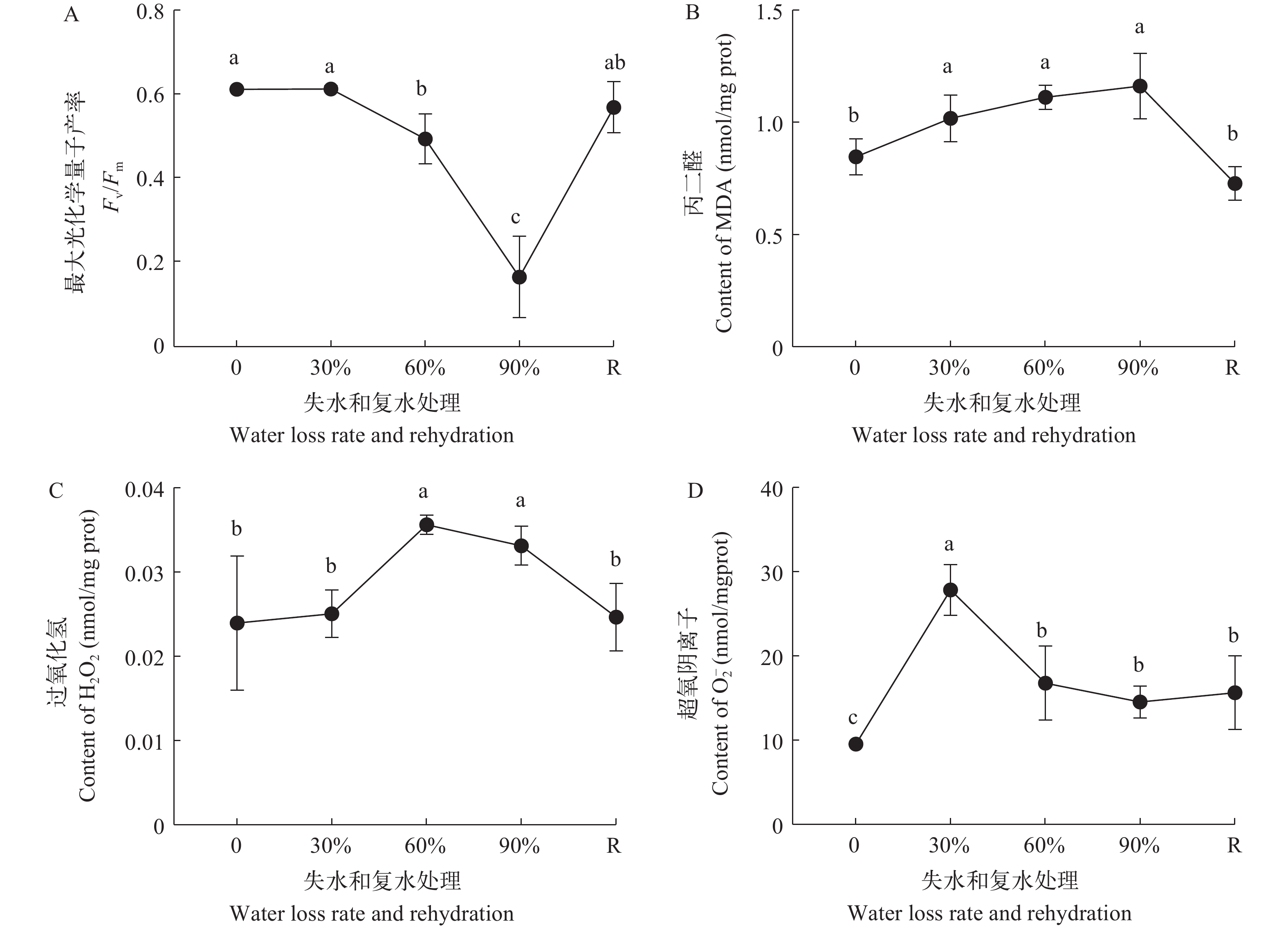
 下载:
下载:
